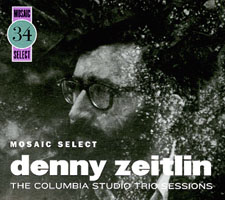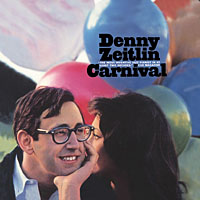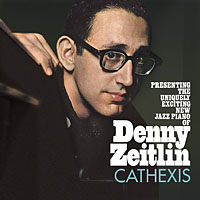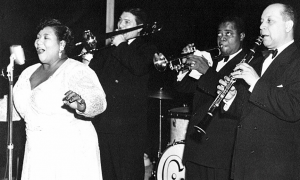Home » Jazz Articles » Highly Opinionated » Denny Zeitlin's Inhabiting a Parallel Universe
Denny Zeitlin's Inhabiting a Parallel Universe
 The artist is alone. Not woefully or desperately alone, but more like willfully alone and enraptured... He empties his head of thought to make way for the flow of air. And in the air, notes of varying pitch and character. They bring their sound alone... then sometimes strung together like necklaces of varying beads—whole ones, halves and quarters... eights... sixteenths... a myriad... The artist feels good to be alone, emptied of all thought now he is prepared for the waves of sound. He sits down at the piano and gives them voice. Denny Zeitlin is playing... deconstructing... exhilarating.
The artist is alone. Not woefully or desperately alone, but more like willfully alone and enraptured... He empties his head of thought to make way for the flow of air. And in the air, notes of varying pitch and character. They bring their sound alone... then sometimes strung together like necklaces of varying beads—whole ones, halves and quarters... eights... sixteenths... a myriad... The artist feels good to be alone, emptied of all thought now he is prepared for the waves of sound. He sits down at the piano and gives them voice. Denny Zeitlin is playing... deconstructing... exhilarating. I am alone in the room and hear Zeitlin deep inside my heart. This is where the notes that first appeared in his head—thoughts and ideas flowing through his brain, veins and fingers—before sprinkling onto the keyboard. And they touch not the auditory senses but on the slate of the heart. The tune is vaguely familiar, but I hear new harmonic variations... a slightly stifled major chord is struck, then new changes revolving like a mad wheel around the original chord in elastic time... and suddenly a melody emerges... It is a Kern—"All The Things You Are" in fact. Bassist Charlie Haden joins in, playing notes like sharp refracted shards of light... then Jerry Granelli—almost tip-toeing on cymbals murmuring loud and soft. My heart begins to beat like a part of the song. I am revealed to myself. All the things I am...can be... all things mentionable and unmentionable... Suddenly I can no longer sit still. My body is swaying and I get up from the chair and allow the music to take over.
Tree sap I am... we are—the song and I together—and a child again... I feel one with the earth and the sky and the rivulet that runs through our property. The song skips as if across a moor I can remember as a child. Many days did I spend there looking for myself in the puddles that glittered and rippled with vast miniature ecosystems? Suddenly I am indoors again. A cool wind wraps the song notes and chords... they skitter in the gathering swirl around my body and begin to trot and gallop at a quickening pace. The music whirls... I whirl too like a dervish. The music is empowering... I forget to breathe and merely swallow the notes of the song. As notes tingle and chords tremble and reverberate around me I realize that every inch of me is ringing in echo of the song's melody. The rhythm inside that melody makes body and soul undulate in gymnastic pirouettes.
Denny Zeitlin's fingers are caressing the piano keys and coaxing the notes to sing. Notes roll over each other, cascading into the heart of the melody. Then Charlie Haden's majestic bass lines and the steady rat-a-tat-and-trinkle-tinkle of Jerry Granelli's drums and cymbals dance around me. I see Jerome Kern and Oscar Hammerstein's classic song in a new light. It murmurs softly, swinging almost relentlessly... then it settles into a long and effervescent impression of a body, boundlessly beautiful. I see it... all the things she is...
The maddening colors of Carnival
 This is Disc 2 of the 3-CD set, Mosaic Select Denny Zeitlin: The Columbia Studio Trio Sessions. I had no intention of listening to this Disc (2) before Disc (1). It was pure chance and I like surprises. I had just heard "Carole's Garden" and wanted to follow that thread, see where it went. The title of this Columbia Studio album, Carnival reminded me of home... Brasil... Or then again, maybe none of the above... The urge to merely gambol was strong... And this is jazz... Denny Zeitlin could have that effect on me too. I had listened to and reviewed his latest record, the brilliant Sunnyside release, Denny Zeitlin Trio/In Concert. Here Buster Williams, Matt Wilson and Zeitlin performed his maddeningly exciting twist on "The Night Has 1000 Eyes," called simply "10,000 Eyes". The reinterpretation of that original Jerome Brainin-Buddy Bernier classic was astounding. It was new harmonically, with a 7/4 vamp and a climactic piano solo...
This is Disc 2 of the 3-CD set, Mosaic Select Denny Zeitlin: The Columbia Studio Trio Sessions. I had no intention of listening to this Disc (2) before Disc (1). It was pure chance and I like surprises. I had just heard "Carole's Garden" and wanted to follow that thread, see where it went. The title of this Columbia Studio album, Carnival reminded me of home... Brasil... Or then again, maybe none of the above... The urge to merely gambol was strong... And this is jazz... Denny Zeitlin could have that effect on me too. I had listened to and reviewed his latest record, the brilliant Sunnyside release, Denny Zeitlin Trio/In Concert. Here Buster Williams, Matt Wilson and Zeitlin performed his maddeningly exciting twist on "The Night Has 1000 Eyes," called simply "10,000 Eyes". The reinterpretation of that original Jerome Brainin-Buddy Bernier classic was astounding. It was new harmonically, with a 7/4 vamp and a climactic piano solo... On Disc 2 of this priceless set, there is more tantalizing deconstruction of standards. Zeitlin seems to revel in this when he approaches a standard. On "We'll Be Together Again," the new changes are very subtle, hidden in the gently swaying rhythm, with just the occasional flurry of fingers in the second chorus. "Once Upon a Summertime" is a redefinition of modern romanticism. The almost somnambulant pace at which the song begins is deceptively challenging in the way that Glenn Gould's famous interpretation of Brahms D Minor Concerto. But summertime can be languorous, so Zeitlin basks in its glory, soaks in the heat of the song and reflects the sense wonder so similar to the way Ray Bradbury once described his own protagonist's sense of wonder in Dandelion Wine. And then there is the extraordinary song "The Boy Next Door," with its semi-tonal shifts and astounding melodic statements verse after verse...
But sandwiched in between the two standards is the title track of this 1964 record—"Carnival." This is an incredible exercise in program music. It begins at a blistering pace and then settles into an intense, evocative study of the almost Bacchanalian aspects of a carnival. The forays into atonality and rhythmic fibrillation are symptomatic of Zeitlin's unusual vision that emerges from his own compositions. Total freedom in Gigi Gryce's "Minority" again... Somehow I sense a hidden, refracted rhythm inside Zeitlin's head. It emerges is in his interpretation of Gryce's "Minority" and more so in a longer, audacious Zeitlin composition, "Labyrinth".
The bountiful energy of Cathexis
 I return to Disc 1. Monk once said that Zeitlin reminded him (once) of Tadd Dameron. So I listening to avoid Dameron for now and slip in Denny Zeitlin's first trio record from earlier in 1964, Cathexis, a record trio record Zeitlin made with Cecil McBee on bass and Freddie Waits on drums. This was the first time—February of 1964—that Zeitlin was able to record his own compositions. It is now impossible to avoid the other aspect of Zeitlin's life—his practice in psychiatric medicine. At that time, however, he was just beginning his studies. But consider the title of his first record Cathexis. Not Latin, but an English translation of the German word, "besetzung," a word that Freud first used and which is known to describe "the amount of psychic energy which is directed toward or attached to the mental representative of a person or thing." The suggestion is brimful with a dynamic tension so great that the suggestion is almost explosive.
I return to Disc 1. Monk once said that Zeitlin reminded him (once) of Tadd Dameron. So I listening to avoid Dameron for now and slip in Denny Zeitlin's first trio record from earlier in 1964, Cathexis, a record trio record Zeitlin made with Cecil McBee on bass and Freddie Waits on drums. This was the first time—February of 1964—that Zeitlin was able to record his own compositions. It is now impossible to avoid the other aspect of Zeitlin's life—his practice in psychiatric medicine. At that time, however, he was just beginning his studies. But consider the title of his first record Cathexis. Not Latin, but an English translation of the German word, "besetzung," a word that Freud first used and which is known to describe "the amount of psychic energy which is directed toward or attached to the mental representative of a person or thing." The suggestion is brimful with a dynamic tension so great that the suggestion is almost explosive. Then Zeitlin sits down to play. "Repeat," the opening song on the record is simple enough, yet has a mesmerizing melodic energy and a superb riff that breaks up the two bopping segments. The energy is palpable, but it gets more urgent by the time I get to "Stonehenge," the C-minor modal piece describing the ancient burial grounds of wizards on the Salisbury Plains in England. There is a racy motif that runs through the song, exploding in parts, egging McBee on while Waits chips away at snare and cymbals. This boundless energy catches fire on the title song, "Cathexis." Although it is easy to confuse this piece—played at great speed—as bebop, it really is not. It is the first time I come face to face with Zeitlin's musical raison d'etre. It is as if he inhabits the known universe of the song—its melody, harmonic and rhythmic variations—and a parallel universe of pure energy that drives the heart and soul of the song, independent of the sounds stated and implied. It is that invisible wave-form that chases the song, running parallel and mimicking its every twist and turn.
On "Blue Phoenix" Zeitlin brings this unique technique to fruition especially in the first section of the piece, where Zeitlin is heard alone for five minutes and four seconds, shaping the song drawing its melodic lines adding rich harmonic colors and textures with his electrifying left hand. McBee and Waits join him in the second part of the song as it develops its blues, an elementally sad section perhaps describing the sunset of the life of the mythical Egyptian bird that is about to nest and die... McBee's solo at the end of this part of the song, although pizzicato, is ruminative and almost dirge like and here begins the reliving of the myth... The pace of the song picks up as if fanning the fire that is consuming the Phoenix, until at about two minutes into Part 3 of the song, bass and drums vanish into thin air and Zeitlin takes over again... using fingers, thumbs in a an all-out two handed assault he fans flames and twirls the song around until it draws in bass and drums resurrecting the original melodic line of the "Blue Phoenix," which proverbially begins its resurrection.
I cannot get enough of Disc 1. It is hard not to lose my breath when I hear the two Gershwin songs, "Soon" and "I Got Rhythm"... the latter is probably the most definitive version I have in my library (Gershwin's excluded). But what a straight one... and herein lies the surprise... Or was Zeitlin merely composing himself like that Phoenix?
The immediacy of Zeitgeist
Now I am drawn not so much to the music at first, but more to the title. What on earth could the significance of Zeitgeist mean in 1966. We were barely over the so-called avant-garde. Don Pullen had made a towering contribution and there was the whole of the "New Thing" going on... all of this a hangover from the early sixties. But this was barely two years after Denny Zeitlin, Charlie Haden and Jerry Granelli had made Carnival. Obviously Zeitlin had a lot more to say, develop his unique technique further... A two handed technique that arose out of the great stride pianists... and then Tatum... Still Zeitlin was his own musician. His compositions posited as such.
 On Disc 3 it all comes to pass. There are three songs here that defy category. In 1966 some would say avant-garde, but it was much more. "Dormammu," a song that refers to a another legend—this time a ruler from another dimension—and strengthens my belief that Zeitlin can, in his music, inhabit parallel universes. So compelling is the sketch of this character who boasts enormous powers of mystery that I am drawn into a dark subterranean world. Zeitlin mesmerizes with plucked strings as the song explodes sucking me into the vortex that bursts with life. Drummer, Oliver Johnson's hands are like magic wands and even when he is walking, his hands move in lightening bursts on smashing across cymbals, punctuated by depth bombs on the bass drum. Joe Halpin—the third trio that Zeitlin used to complete the Columbia Sessions—is up to the challenge of the song that bounces off invisible surfaces as it traces the character's explosive power across the narrative. His solo that precedes Zeitlin's assault n the strings and keyboard is a true revelation of feverish rhythmic intensity.
On Disc 3 it all comes to pass. There are three songs here that defy category. In 1966 some would say avant-garde, but it was much more. "Dormammu," a song that refers to a another legend—this time a ruler from another dimension—and strengthens my belief that Zeitlin can, in his music, inhabit parallel universes. So compelling is the sketch of this character who boasts enormous powers of mystery that I am drawn into a dark subterranean world. Zeitlin mesmerizes with plucked strings as the song explodes sucking me into the vortex that bursts with life. Drummer, Oliver Johnson's hands are like magic wands and even when he is walking, his hands move in lightening bursts on smashing across cymbals, punctuated by depth bombs on the bass drum. Joe Halpin—the third trio that Zeitlin used to complete the Columbia Sessions—is up to the challenge of the song that bounces off invisible surfaces as it traces the character's explosive power across the narrative. His solo that precedes Zeitlin's assault n the strings and keyboard is a true revelation of feverish rhythmic intensity. Now my own name for Zeitlin's unique and stylish approach to song and performance is beginning to form in my mind, echoing with melody, harmony glued together with his rhythmic ingenuity. But it is the way the song appears to shape itself as if in two parallel realities that bedazzles. It is like watching a Double Helix form before my eyes as the song unfurls and plays itself at the pianist's hands—both hands in fact.
The way he takes apart and re-fixes Herbie Hancock's "Maiden Voyage" is a true wonder of unique style and vision. It appears now that Denny Zeitlin can play almost music, from any era, by any composer and make it his own. It is poetic justice for Zeitlin to insert Cole Porter's "Night and Day" here... if nothing then simply to describe his approach to music, which has almost never been heard before.... This just before the pianist returns with bassist Haden and drummer Granelli to launch into the unfettered freedom of "Mirage". To attempt to describe the experience of it meter would be to destroy its surprise... Suffice it to say that "Mirage" inhabits the horizon where sound and vision, music and color and texture fuse in the miasmatic realm of a wet canvas.
The paint is still wet on Denny Zeitlin's music that swirls around in my mind, split by the pianist into the real, tangible one that I feel I can reach out and touch... almost ad a note or two even while he is playing. But then there is that onrushing sound of the song that appears to come from another dimension. I freeze eyes closed and let the music's energy take me body, soul and spirit to that place where Denny Zeitlin alone can mend broken thoughts about how music should sound... how it should be... and I return edified... whole again found, as if by magic in Denny Zeitlin's labyrinth.
< Previous
Power to the Babies
Next >
Sided Silver Solid
Comments
Tags
Denny Zeitlin
Highly Opinionated
Raul D'Gama Rose
United States
Charlie Haden
Jerry Granelli
Tadd Dameron
cecil mcbee
Don Pullen
For the Love of Jazz
 All About Jazz has been a pillar of jazz since 1995, championing it as an art form and, more importantly, supporting the musicians who create it. Our enduring commitment has made "AAJ" one of the most culturally important websites of its kind, read by hundreds of thousands of fans, musicians and industry figures every month.
All About Jazz has been a pillar of jazz since 1995, championing it as an art form and, more importantly, supporting the musicians who create it. Our enduring commitment has made "AAJ" one of the most culturally important websites of its kind, read by hundreds of thousands of fans, musicians and industry figures every month.























